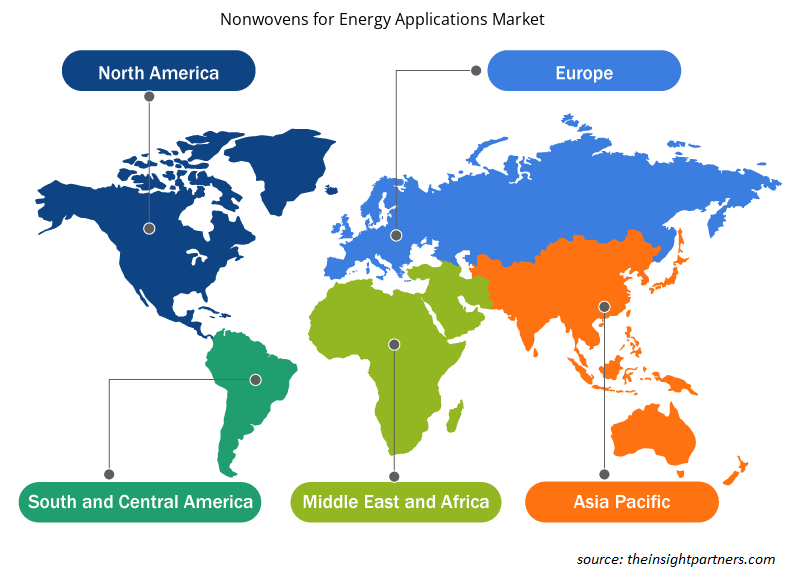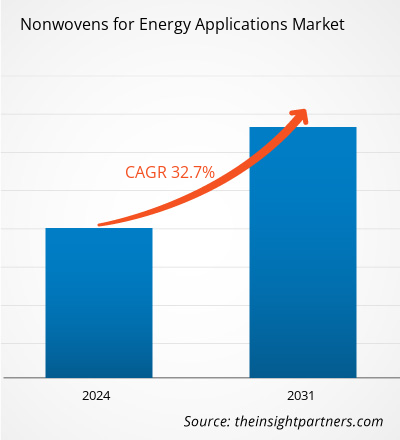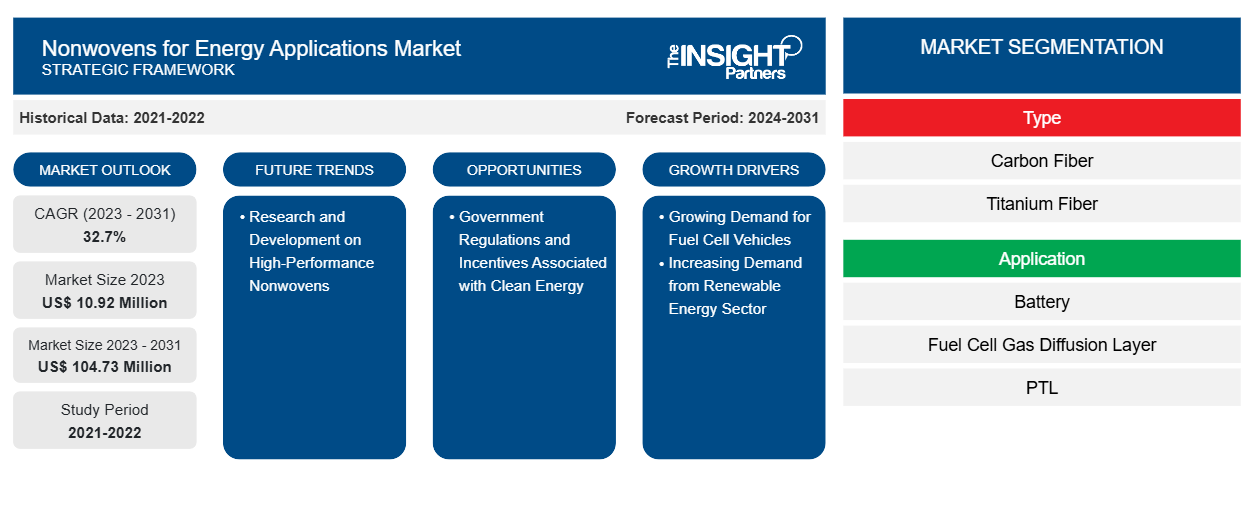预计到 2031 年,能源应用非织造布市场规模将从 2023 年的 1092 万美元增至 1.0473 亿美元。预计 2023-2031 年期间市场复合年增长率将达到 32.7%。为满足各行各业的苛刻应用需求,高性能非织造布的研发可能会为能源应用非织造布市场带来新趋势。
能源应用非织造布市场分析
汽车行业向绿色和可持续技术的转型催化了燃料电池汽车的开发和应用。因此,对包括无纺布在内的先进材料的需求也在增加。根据《氢能发展规划》,中国已设定了到 2025 年在道路上拥有 50,000 辆燃料电池汽车的目标。2024 年 7 月,美国交通部宣布向 117 个公共交通项目提供 15 亿美元,用于零排放和低排放汽车。无纺布是燃料电池系统的重要组成部分,可提高性能和效率。在燃料电池中,无纺布用于气体扩散层、质子交换膜和绝缘材料。静电纺丝和纳米纤维生产等无纺布制造技术的进步正在增强无纺布材料的性能特征。
能源应用非织造布市场概览
随着各行各业寻求先进材料来提高能源系统的性能、效率和可持续性,能源应用无纺布市场正在经历强劲增长。无纺布以其多功能性、轻质性和可定制特性而闻名,越来越多地用于各种能源相关应用,包括电池、燃料电池和风能。在能源存储领域,无纺碳纤维材料对于提高电池和燃料电池的性能至关重要。碳纤维无纺布用于生产电池电极,其导电性能有助于提高储能容量和效率。
定制此报告以满足您的需求
您可以免费定制任何报告,包括本报告的部分内容、国家级分析、Excel 数据包,以及为初创企业和大学提供优惠和折扣
- 获取此报告的关键市场趋势。这个免费样品将包括数据分析,从市场趋势到估计和预测。
能源应用非织造布市场驱动因素和机遇
可再生能源领域的需求不断增加
由于人们广泛努力应对气候变化和加强能源安全,可再生能源行业正在经历快速增长。根据国际能源署 2023 年报告,全球可再生能源发电能力预计将在未来五年内增加,其中太阳能光伏和风能占发电能力的 96%,因为它们的发电成本低于化石和非化石替代品。预计到 2028 年,太阳能光伏和风能发电能力将比 2022 年翻一番。可再生能源行业经济吸引力的持续增长,加上政府政策支持力度的加大,尤其是中国、美国、欧盟和印度,预计将在未来几年加速发电能力的增长。根据全球风能理事会的数据,2022 年,全球新增风电容量为 77.6 吉瓦并入电网,总装机容量为 906 吉瓦,与 2021 年相比增长 9%。
与清洁能源相关的政府法规和激励措施
政府政策对氢燃料电池和清洁能源技术有重大影响。这些政策影响对先进材料的需求,包括无纺布,这对于提高能源系统的性能和效率至关重要。世界各国政府都设定了降低碳排放的雄心勃勃的目标,鼓励采用清洁能源技术。例如,欧盟的目标是到 2050 年实现净零排放。如此严格的排放标准要求开发高效的能源系统,从而推动氢燃料电池和清洁能源技术对无纺布的需求。一些政府还在制定促进绿色氢气生产的战略,利用可再生能源电解水。2023 年 12 月,英国能源安全大臣宣布为 11 个通过电解生产绿色氢气的项目提供资金。2024 年 5 月,Hydrogen Ukraine 和 AB5 Consulting 获得了一项拨款,用于在乌克兰开发其可再生氢项目。该项目由英国国际发展署下属的 Innovate Ukraine 资助。
能源应用非织造布市场报告细分分析
- 根据类型,能源应用无纺布市场分为碳纤维、钛纤维和其他。碳纤维领域在 2023 年占据市场主导地位。
- 根据应用,市场细分为电池、燃料电池气体扩散层 (GDL)、PTL 和风能。燃料电池气体扩散层 (GDL) 部分在 2023 年占据能源应用非织造布市场的最大份额。
能源应用非织造布市场份额按地区分析
能源应用非织造布市场报告的地理范围主要分为五个区域:北美、亚太、欧洲、中东和非洲、南美和中美。
2023 年,亚太地区占据最大市场份额,预计在预测期内将实现最高复合年增长率。随着电池技术的不断改进,亚太地区有望成为新能源汽车生产的重要枢纽。在政府推广电动汽车的政策支持下,中国已成为全球最大的电动汽车市场之一。据中国汽车工业协会称,2023 年中国燃料电池电动汽车销量约为 6,000 辆,同比增长 72%。亚太地区的几个经济体计划按照政府的要求扩大新能源汽车产业,以支持未来几年该地区燃料电池电动汽车的增长。根据 2022 年发布的氢能发展计划,中国已设定了到 2025 年底在道路上投放 50,000 辆燃料电池汽车的目标。
能源应用非织造布市场区域洞察
Insight Partners 的分析师已详细解释了预测期内影响能源应用非织造布市场的区域趋势和因素。本节还讨论了北美、欧洲、亚太地区、中东和非洲以及南美和中美洲的能源应用非织造布市场细分和地理位置。

- 获取能源应用非织造布市场的区域特定数据
能源应用非织造布市场报告范围
| 报告属性 | 细节 |
|---|---|
| 2023 年的市场规模 | 1092万美元 |
| 2031 年市场规模 | 1.0473亿美元 |
| 全球复合年增长率(2023 - 2031) | 32.7% |
| 史料 | 2021-2022 |
| 预测期 | 2024-2031 |
| 涵盖的领域 | 按类型
|
| 覆盖地区和国家 | 北美
|
| 市场领导者和主要公司简介 |
|
市场参与者密度:了解其对商业动态的影响
能源应用非织造布市场正在快速增长,这得益于终端用户需求的不断增长,而这些需求又源于消费者偏好的不断变化、技术进步以及对产品优势的认识不断提高等因素。随着需求的增加,企业正在扩大其产品范围,进行创新以满足消费者的需求,并利用新兴趋势,从而进一步推动市场增长。
市场参与者密度是指在特定市场或行业内运营的企业或公司的分布情况。它表明在给定市场空间中,相对于其规模或总市场价值,有多少竞争对手(市场参与者)存在。
在能源应用非织造布市场运营的主要公司有:
- 技术纤维产品
- 泰克科技工业公司
- 科德宝集团
- SGL 碳素公司
- 莱德尔公司
- 阿斯顿约翰逊公司
免责声明:上面列出的公司没有按照任何特定顺序排列。

- 获取能源应用非织造布市场顶级关键参与者概述
能源应用非织造布市场新闻和最新发展
通过收集一手和二手研究的定性和定量数据来评估能源应用非织造布市场,其中包括重要的公司出版物、协会数据和数据库。能源应用非织造布市场的一些发展如下:
- Technical Fibers Products 宣布推出高性能碳纤维无纺布,在电池技术领域取得突破性进展。(来源:James Cropper PLC,公司新闻,2024 年 7 月)
- 东丽工业公司宣布开发 TORAYCA™ T1200 碳纤维,其强度为 1,160 千磅/平方英寸 (Ksi),为世界最高。这项新产品将鼓励该公司通过减轻碳纤维增强塑料材料的重量来减少对环境的影响。(来源:东丽先进复合材料,新闻稿,2023 年 10 月)
能源应用非织造布市场报告范围和交付成果
“能源应用非织造布市场规模和预测(2021-2031)”报告对以下领域进行了详细的市场分析:
- 能源应用非织造布市场规模以及范围内所有主要细分市场的预测
- 能源应用非织造布的市场趋势,以及市场动态,如驱动因素、限制因素和关键机遇
- 详细的波特五力分析和 SWOT 分析
- 能源应用非织造布市场分析涵盖主要市场趋势、国家框架、主要参与者、法规和最新市场发展。
- 行业格局和竞争分析,涵盖市场集中度、热图分析、知名企业以及能源应用非织造布市场的最新发展
- 详细的公司简介
- 历史分析(2 年)、基准年、预测(7 年)及复合年增长率
- PEST和SWOT分析
- 市场规模、价值/数量 - 全球、区域、国家
- 行业和竞争格局
- Excel 数据集
近期报告
客户评价
购买理由
- 明智的决策
- 了解市场动态
- 竞争分析
- 客户洞察
- 市场预测
- 风险规避
- 战略规划
- 投资论证
- 识别新兴市场
- 优化营销策略
- 提升运营效率
- 顺应监管趋势





















 获取免费样品 - 能源应用市场用无纺布
获取免费样品 - 能源应用市场用无纺布